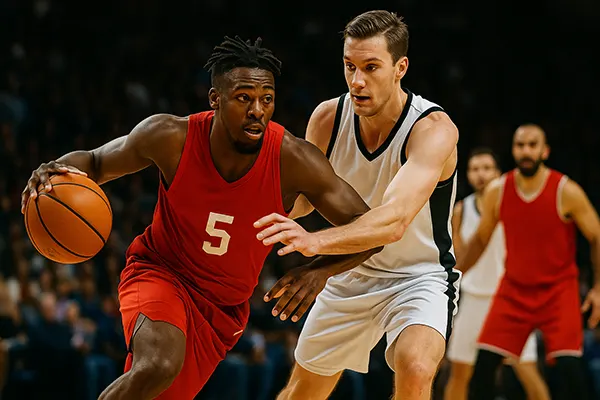Basketball, though born in the United States, has evolved into two distinct schools of thought: the dynamic, entertainment-driven NBA and the strategically intricate EuroLeague. Both styles share the same fundamentals yet reflect entirely different sporting cultures, tactical priorities, and player development systems.
Tactical Contrasts Between the NBA and EuroLeague
The NBA prioritises fast-paced offence and isolation plays, allowing players to showcase individual talent. Games often feature high scores, quick transitions, and an emphasis on athleticism and one-on-one duels. In contrast, EuroLeague basketball operates on slower tempo, valuing collective movement and half-court execution where every possession counts.
European teams rely on structured offensive sets, heavy use of pick-and-roll systems, and positional discipline. Coaches in Europe place strong emphasis on ball circulation, spacing, and reading defensive gaps, whereas in the NBA, offensive creativity is often entrusted to star players capable of improvising under pressure.
Defensive organisation also distinguishes the two. EuroLeague teams favour zone defences and switching tactics to counter physical disadvantages, while the NBA prioritises man-to-man schemes due to defensive three-second rules, creating more open space for scorers.
Coaching Philosophies and Game Control
Coaches in the EuroLeague act as tactical architects who control every aspect of the game. They frequently make adjustments during possessions, calling complex set plays from the sidelines. Their authority is significant, and players are expected to execute systems precisely rather than rely on individual flair.
NBA coaches, on the other hand, provide frameworks for star-led play. Timeouts and rotations are planned around player endurance and offensive flow, but freedom on the court remains a key feature. The league’s entertainment model values creativity and showmanship, allowing athletes to dictate rhythm and tempo within broad strategies.
In 2025, the line is blurring slightly as more NBA teams adopt European-style spacing and off-ball movement, while EuroLeague sides increasingly study NBA analytics to improve scoring efficiency and shot selection.
Player Rotation and Team Dynamics
Roster management reflects another philosophical divide. NBA teams, with 82 regular-season games, prioritise depth and rotation to prevent fatigue, often resting stars during the season. In contrast, EuroLeague teams play fewer matches but at higher tactical intensity, using shorter rotations and disciplined role assignments.
European squads value chemistry over raw talent. Bench players are selected for compatibility within systems rather than individual scoring ability. In the NBA, star duos or trios dominate the offensive identity, and team structures are often built around maximising their impact.
By 2025, the EuroLeague’s emphasis on teamwork continues to attract attention from NBA franchises aiming to build sustainable winning cultures. Examples include Boston’s analytical approach and Denver’s collective passing model inspired by European schemes.
Team Cohesion and Cultural Identity
In Europe, basketball represents regional pride and local identity. Fans perceive clubs as long-term projects tied to their cities, fostering loyalty and strategic continuity. This cultural stability encourages the development of cohesive squads where every player understands their role across multiple seasons.
In the NBA, the commercial nature of the sport drives frequent roster changes and trades. Stars hold significant influence, which can lead to volatile team dynamics but also create short-term bursts of excellence. Player movement fuels narratives but can disrupt chemistry.
However, the 2025 NBA landscape shows a growing trend toward stability — franchises like the Milwaukee Bucks and Denver Nuggets prioritise long-term development, mirroring the European model’s consistency.

The Role of Individuality and Collective Systems
The NBA’s hallmark remains its individual superstars. Players such as Luka Dončić and Jayson Tatum represent the league’s commitment to creative autonomy, where personal brilliance can determine the outcome of entire series. Individual achievements fuel global popularity and commercial success.
Conversely, EuroLeague teams depend on collective synergy. Success stories like Real Madrid and Anadolu Efes highlight how balance, shared responsibility, and tactical cohesion can outperform star-centric opponents. Players are moulded to serve the system, not dominate it.
This difference deeply affects player development pathways. American prospects are trained early to excel in isolation play, while European systems nurture decision-making, teamwork, and defensive awareness — skills that seamlessly translate to professional leagues worldwide.
Impact on the Next Generation
Young athletes entering the global basketball scene face a crossroads between these philosophies. The American route emphasises exposure, athletic testing, and highlight culture, while the European route rewards patience, discipline, and tactical maturity. Both paths produce world-class talent, yet with different mindsets.
In 2025, more NBA franchises invest in European academies, recognising the value of early tactical education. Meanwhile, EuroLeague teams collaborate with American coaches to improve athletic conditioning and transition play, merging strengths from both continents.
Ultimately, basketball’s future lies in synthesis. The next generation of stars — shaped by global influences — will bridge the stylistic gap, combining European teamwork with American creativity to redefine the sport’s identity worldwide.
